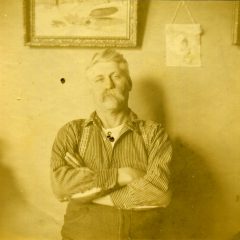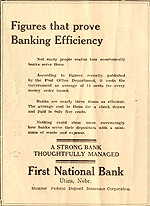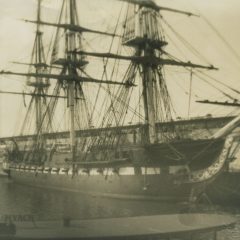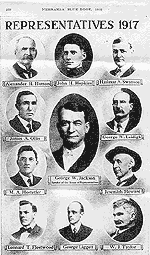The Common Thread
Two of the great great grandsons of James M. Liggett of Armagh, George Harlan Jr. (my uncle and James Guinn (Jim – my father), characterize the Liggetts as entrepreneurs, “felt land was something to value and invest in.” W.W. Cox describes this characteristic of their great grandfather, the first George Liggett, in his 1905 history of Seward County: “George Liggett who took up a homestead on Lincoln Creek in 1869, commenced the grain trade in the new town when the station was first established. Mr. Liggett only enjoyed the pleasures of a farmer’s life one year, when he moved to Seward where he tried his hand at harness making for a time when he thought he saw glory or wealth in Antelope County and removed to that locality. He soon secured all the glory he needed and gave up the idea of wealth and like a sensible man he returned to Seward where he studied the art of buying grain. After graduating among the grain men of Seward, he went to Utica and there he commenced the practice of his profession with remarkable success as his ample possessions demonstrate.”
George’s sons, James Bela and Cassius George, as described in previous chapters, were also successful entrepreneurs. J.B.’s son, Hal, my grandfather, tried his hand at starting a few businesses: selling radios, incubators to farmers (Queen Incubator), and chickens to the railroad, but was hampered in his efforts by the Great Depression. He then took advantage of opportunities this created in government by working for agencies created to help end this economic calamity. The Liggett entrepreneurial spirit in his uncle George, son of Cassius, was also challenged by the Depression, but he was able to keep his family’s bank from closing like so many others in America at the time.
My uncle and father go on to describe the Liggetts, “they have held on to and invested in the family’s Nebraska farms; Liggetts are sensitive, thin-skinned; debaters, strong opinions and convictions (Jim was president of the debate club in high school and his niece, Martha, is an attorney and lobbyist); independent, persistent; small families – one or two children with a large age range; neighborhood Christians; value education – their father George Harlan Sr (Hal) and mother, Grace, were teachers (as well as the second George Liggett’s wife, Charlotte, and my dad, Jim). The great grandchildren of James M. Liggett (George Harlan, George Hermann, Lee, and Ted) were the first generation to go to college and turned to the medical, legal, and banking professions, as well as government. They also served their country during the World Wars.
The Liggetts like small farm animals – raising them for food, income, and as pets. Hal had his portrait taken as a child with a rooster and had chickens in the backyard, just like his father. The families in each generation have pet dogs and/or cats. Jim and his brother, George, had a Scottish terrier when they were kids. Later Jim had a pet turkey and goose. Their grandfather, James Bela, had a Russian blue cat named after the blue green Gilmore Gas. J.B.’s daughter, Anna, says that her dad had a pet snake at his farm in Palm City and went to find him and move him to a ridge when the alfalfa field was irrigated. Like Beatrix Potter did in Perthshire, Scotland, seventh generation, Aaron, had a pet rabbit.
The Liggetts like to tell jokes and stories. A frequent subject is stories about James Bela Liggett’s brother-in-law. “Warriners fell into a pot of gold. Harry Warriner always had gravy on his necktie. He had land in downtown San Diego and a ranch in National City. Freeway went through the ranch. Harry and his wife were both college educated and taught their kids, Harlan, May, (another boy who died as a child) and Jennie Joe, at home. They liked to travel. Harry would buy new cars and then store them in the barn when they didn’t run anymore. Cars later became valuable without any forethought of that. Only one child, Jennie Joe, was schooled – went to San Diego State. She became a missionary in South America, came back to San Diego for an anticipated difficult delivery, and died in childbirth.” Jim wrote an essay about his great Uncle Harry for his college English class that was entitled “The Visionary.”
Harry Warriner is a dreamer. All his life he has been scheming to make a lot of money quickly. Every few days he starts a new scheme, which will later be dropped, as the previous one has been when he stopped to pick up a new tool or drop everything to go fishing.
A first impression is that he is an individual with a free will. His first utterance reveals that his thoughts are child-like and unorganized. His face and carriage are those of a high school boy who has had little exposure to work; yet he is nearly thirty. At his parents insistence he wore skirts and shoulder-length curls until he was twelve. Once he barely escaped being pounced on by ruffians who wished to determine his sex.
From early childhood, his life has been spent in a series of long vacations interspersed by relatively short periods of work. He has no formal education and he has never lived by a schedule. Since his parents are both college graduates, his spoken vocabulary is that of a college man, but can neither read or write above the level of a third grader. He had a brief exposure to normal life when he was drafted into the Navy for a few months, but he was already too set in his ways. The only apparent improvements are that he now combs his hair and carries a fountain pen.
There is one thing in common with all of Harry’s adventures: none of them appear to be sound until his uncanny luck sticks again. He built a filling station at the intersection of two county lanes. Before he had it finished both roads were highways leading to Army camps. He bought an ancient car in Baltimore, Maryland, and drove it 3000 miles to his home without so much as a flat tire, but as he entered his farmyard the motor froze and the car stands there today.
He is headed nowhere and is leaving in his wake an accumulation of waste: tile laid halfway across the kitchen, fourteen defunct cars and a yard full of such things as a bath tub, portable kitchen, and enough material to build several more houses.
He lives from day-to-day; his mysterious luck provides him a living; his waste accumulates about him and remaining as a monument to the dreamer.
Figures and money management are the primary subjects of letters between my great grandfather, James Bela Liggett, and his son, Hal, in 1927 (George Harlan was 28, married to Grace, and their son, George Jr., was 4),
“There is no hurry about making out new leases they are only necessary in case you want to change renters. I think you will have to change Burris for he is raising little but weeds. I want it in the lease that Sudan or cane is $10.00 cash rent that is one they are always slipping in and allowing some number of rows of corn and then forgetting it when the husk Remember the rent is 2/5 of corn, 1/3 small grain, $8.00 alfalfa, $6.00 sweet clover and $4.00 with fracture if in doubt about their cash… The report you sent me on the Britt deal I would say it was the bunk no man ever sold an interest in a business paying 30% on the investment below … The Waco farm would hardly be fit for a dairy farm not enough pasture or hay.
I’m glad Grace got in the city school if she wants to teach and hope your girl will prove satisfactory. Your figures are ok except you forgot that it cost something to feed the girl. If your boss would overlook that big an item in his costs he wouldn’t be hiring you long. (Later)
I’m glad you have been able to get your expenses within your salary and if Grace don’t teach you don’t need any help in the house. (A few months later)
“Now don’t think because I let you look after the farms that I opened my account to your drawing for I did not and don’t know why you took the liberty to draw on me without my saying so and will let you know that the next one will be returned for I wrote George that he should turn down any more that I don’t ok. I don’t know how you expect to pay any thing back when you acknowledge you are running behind all the time. You said you were going to live with in your income and then the very first month you draw on me for $100.00 like you had a drawing account…Don’t kick about your job to me I tried my damndest to get you to stay where you were getting ahead and you wouldn’t do it you were going to farm.”
James Bela Liggett’s brother, George, was jokingly described by an editor in the 1920’s when he said, “At the meeting members (of the NE Legislature) were asked to describe what books they liked best and George Liggett said: ‘Give me ten big bank books!'” A focus on figures is seen in a July 13, 1939, advertisement in the Utica Sun for George Liggett’s First National Bank, which has a heading of “Figures that prove Banking Efficiency”:
Subsequent generations of Liggetts have earned their living in the health care field, an interest also expressed by J.B. Liggett, in letters to his son, in 1927:
“A sure cure for a boil or carbuncle is Lloyds Echinacea. Just place the tongue on the bottle 10 or 12 times in a day for a taste and rub a little on the boil 2 or 3 times a day and they are soon gone and no more will come Tell Mr. Guinn if he hasn’t had his appendix out he still has something for the doctors to work on when he don’t feel well.”
Anna recalls her father, J.B., doing surgery several times on one of his Plymouth Rock egg laying chickens to remove a digestive blockage from too much grass. J.B. died at home refusing to get care from a doctor, however.
The Liggetts are also interested in civic events and affairs. In 1927, J.B. writes to his son about events in San Diego,
“I see by tonight’s paper that Lindbergh reached New York in his Ryan made monoplane. If he gets to Paris, San Diego will get a big boost as plane manufacturing center. (A few months later) Maude Leah Roberts and family were down for the Lindbergh celebration and stayed until last evening and we have been on the go most of the time I think by far the largest crowd ever in San Diego was here.
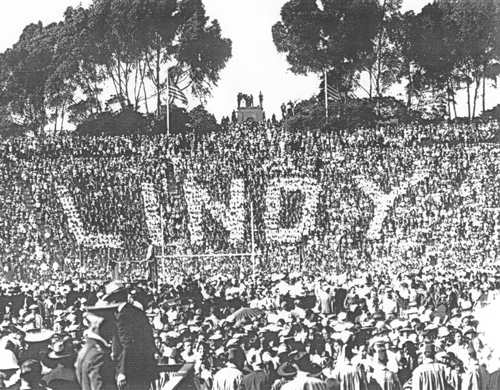
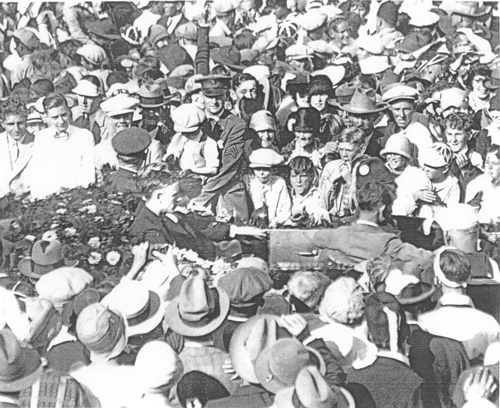
He flew the first plane from here to LA Thursday starting regular passenger service the planes carry 14 people . The Athletic Club took out a permit for 14 story building at 7th and A and San Diego Savings Bank for a 14 story at 6th and Broadway.” (See picture below.)
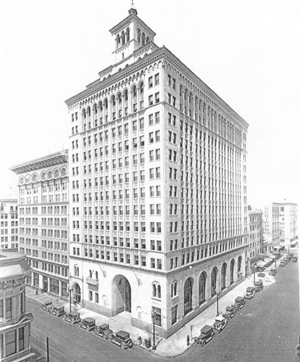

James Bela took this picture of the recently arrived Star of India in December 1933.
J.B.’s brother, George Liggett, Jr. was also very interested in civic issues. It was noted in the Utica Sun for January 25, 1912, “George Liggett, Jr. offers to run saloons and put the whole net income into the new schoolhouse.” With tongue in cheek, no doubt! February 1: “Utica will have a Farmer’s Institute through the efforts of George Liggett Jr. et others.” February 28: “Farmer’s Institute a Success: Officers for Next Year Include Geo. Liggett, Jr., Secretary.” September 26: Geo. Liggett, Jr., committeeman, Republican Caucus.” January 30, 1913: “Geo. Liggett, Jr., guest of honor and speaker at Farmer’s Institute banquet, Lincoln.” March 19, 1914, the Omaha Nebraskan says: “George Liggett of the First National Bank of Utica was in Omaha…one of the live leaders in commercial affairs in his home town and one of the active men of the state.”
The year their father died, on July 16, 1914, George Liggett’s picture appeared in the Sun with the announcement that he would be the Republican candidate for nomination as representative of Seward County. His advertisement said, “If nominated and elected I will endeavor to keep down public expenditures so taxes will be lower, and will do my utmost to bring about economical management of the business of the state.” By October, he expanded on his stand: “I am opposed to university removal, building armories at Omaha and Nebraska City, junior normals, unnecessary employees in the legislative and excessive appropriations – in favor of taking our schools out of politics, placing state employees under civil service,etc. “was elected to the Nebraska State Legislature in November, 1914, representing the 36th District as a Republican, after attaining statewide recognition as an active businessman in Utica.
The 1915 Legislature reports about George Liggett’s priorities include: “Representative Liggett has introduced bill to abolish board with control over state normal schools and place under board of regents… Liggett and others a bill to do away with precinct assessors and have instead precinct assessment board… a Liggett bill to abolish state normal schools… Liggett bill to compel landowners to trim hedges at crossroads to do away with the danger of auto collisions…bill by Liggett prohibits school boards from hiring teacher if under contract to another district…”
In his second term, George proposed a law requiring the distribution of freight cars on the basis of the amount of grain shipped; introduced a bill providing for the physical valuation of the Omaha Stock Yards (which passed the House with only one dissenting vote); additional bills provided for the dimming of headlights on automobiles, regulation of traveling doctors, and the amending and improving of the bank guaranty law.”
The “slender pine from up the creek” was also described as “the cleanest cut, most tidy appearing and best dressed man of the entire body” in a June 1924 article of the Seward Independent. George’s wife, Charlotte, was also involved in civic affairs and politics. She served on the school board, as did their son, George Jr.
After compiling this family history, I find these descriptions of our Scotch-Irish heritage to coincide with many of the Liggett family values and traits. From the book, The Scotch-Irish Americans:
“Strong, courageous, and stubborn. As a group, they were characterized as industrious, pragmatic, frugal, clannish, and reserved. Many Scottish immigrants came from tenant farms where the harsh climate and topography made farming a struggle. These conditions bred a respect for hard work and a certain severity of temperament, traits compounded by the Scot’s Presbyterian faith. As Presbyterians, they believed that religion was a serious, personal responsibility, and they valued education so that all might be able to read the Bible.
There are three distinct groups: the Lowland Scots, the Highland Scots, and the Scotch-Irish the latter first emigrated from Scotland to Ireland. In the 17th century, the British, who were trying to subdue the Irish, encouraged Protestants from southern Scotland to settle on the captured lands of Irish Catholics. Thousands of Scots migrated to Northern Ireland, and many stayed for several generations. They lived there, however, in a state of perpetual and often bloody conflict with the Irish Catholics. Many ultimately left for North America in the late 18th and early 19th centuries. Because they had lived in Ireland for several generations before coming to the New World, their experiences were very different from those who came directly from Scotland…
The term Scotch-Irish is an American invention, first coined in 1695. Theodore Roosevelt wrote: “The backwoodsmen were American by birth and parentage, and of mixed race; but the dominant strain in their blood was that of the Presbyterian Irish – the Scotch Irish, as they are often called Mingled with the descendants of many other races, they nevertheless formed the kernel of the distinctively and intensely American stock.”
The qualities that distinguished Scotch-Irish pioneers were embodied in the frontiersman Davy Crockett who often bragged about his exploits in colorful language. The Scotch-Irish love for colorful storytelling, or “tall tales,” enriched America’s common speech. Such lively phrases as “getting mad as a meat axe” and having “an axe to grind,” “sitting on the fence” instead of “going the whole hog,” are part of the linguistic legacy. Even the expression “you-all,” identified with the American south, had its roots in the Scotch-Irish translation of the second person plural form of address.
Ten U.S. Presidents were of Scotch-Irish extraction, including Andrew Jackson and Woodrow Wilson. When Wilson was president of Princeton University, he initiated an academic reform plan, “the preceptorial” system which provided for small discussion groups to supplement lectures (which, he believed, did not encourage students to think for themselves) and a quad plan to integrate student social lives because there was too much emphasis on athletics and social life.
In 1980, it was estimated that 20 million, or 1 out of 12 people in the U.S. can claim some Scotch-Irish lineage. The Scotch-Irish “Navigated into the Mainstream,” by community organizing, but had to overcome prejudices based on class distinctions other Americans sometimes “looked down upon” the Scotch-Irish, especially in Boston. This activity did notinclude politics, as generations of oppression at the hands of the British crown had soured the group on centralized authority. They supported the elections of Thomas Jefferson and Andrew Jackson who wanted to limit the powers of the Federal Government.
The Scotch-Irish are described as “high spirits” for this anti-Catholic sentiment and an “abiding taste for strong drink.” According to an old Appalachian saying, when English settlers arrived they built a house, the Germans built a barn, and the Scotch-Irish built a distillery. The Ulster tradition of homemade whiskey thrived in America. Equally volatile was the Scotch-Irish sense of humor. Ulster Scots had a great love for practical jokes, and enjoyed quick-witted sarcasm and the joke made at another’s expense. However, it is also noted that the forces that moved millions across the Atlantic and cast them throughout a wild new country also formed some of the most versatile and determined people on the North American continent.
The chapter of The Scotch-Irish Americans, entitled “Restlessness and Achievement”, notes that, “Fourteen descendants of Ulster were signers of the Declaration of Independence, and generals in the Civil War, including Ulysses S. Grant and Stonewall Jackson Clearing and cultivating land occupied many Scotch-Irish settlers, but few prospered at it They were mental explorers: inventors Cyrus McCormick and Robert Fulton, Thomas Alva Edison… A gift for language and a deep respect for literature… William McGuffey devised the first widely distributed readers for elementary school children. Horace Greeley transformed newspapers from dull society sheets and sensationalistic rags to forums for investigative journalism and public opinion. He co-founded The New Yorker and was editor of the Jeffersonian Captains of Finance, Thomas Mellon and his son Andrew, like many Scotch-Irish, were consumed by their work. Andrew Mellon was director or officer of more than 60 different corporations. He founded the Gulf Oil Company, the New York Shipbuilding Company, and US Steel. He backed engineering and construction projects, including the Panama Canal locks and the Waldorf-Astoria Hotel. His main business interest, however, remained the family-banking legacy. He used his riches to buy, collect, and bequeath art objects.
Scotch-Irishman, Thomas Eakins (example below) painted some of the most remarkable works produced by an American. A later Scotch-Irish painter, Jackson Pollack invented action painting.

The pioneer spirit, expressed so intensely by Sam Houston and Davy Crockett, has perhaps been absorbed into the larger – now more diverse – American character. They played a vigorous role in settling the US and Canada. When Americans look back at their history’s greatest figures, they see a gallery that includes many Scotch-Irish pioneers, soldiers, and statesmen. This ethnic group’s dedication to freedom has influenced the lives of subsequent immigrants from around the world, who have gone one to shape their own American frontiers.”


